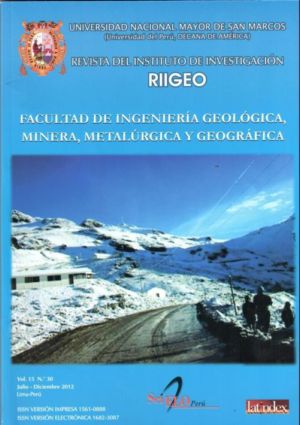Biorremediación de suelos contaminados por hidrocarburos mediante el compost de aserrín y estiércol
DOI:
https://doi.org/10.15381/iigeo.v15i30.4101Palabras clave:
biorremediacion, hidrocarburos, estiércol orgánico, aserrínResumen
La biorremediación de suelos contaminados por hidrocarburos es una técnica que consiste en usar organismos vivos para el consumo de los hidrocarburos de petróleo en el suelo. Para descartar la disminución de Hidrocarburos Totales de Petróleo de un suelo de la Refinería la Pampilla, ubicado en la Carretera Ventanilla km 25, distrito de Ventanilla, provincia del Callao. Se instaló el experimento a nivel de bioensayo, en el Laboratorio de Fertilidad de suelos de la Universidad Nacional Agraria La Molina, aplicándose el modelo estadístico de Diseño Experimental Completamente al Azar (DCA), con tres repeticiones y doce tratamientos sumando un total de 36 macetas experimentales, para lo cual se empleó estiércol y aserrines como sustrato a la planta indicadora de “maíz” (Zea mays L.), sembrados y controlados por un periodo de dos meses. Los resultados de la dosificación del suelo contaminado por hidrocarburos, estiércol y aserrín en promedio disminuyó 22.5% el contenido de hidrocarburos en el suelo, empleando solo estiércol disminuyó 16.5% y usando solamente aserrines disminuyó 9.6%. Comparando los tratamientos del experimento el que mejor ha remediado los suelos fue el tratamiento (T3) suelo contaminado más vacaza más aserrín de bolaina, puesto que la concentración inicial de hidrocarburos totales de petróleo (TPH) fue de 21.81 gr de TPH/kg de suelo, ha disminuido en 16.28 gr de TPH/kg de suelo, que representa una reducción del 25%. Siendo este tratamiento lo más recomendable a usar.Descargas
Publicado
Número
Sección
Licencia
Derechos de autor 2012 Hildebrando Buendía R.

Esta obra está bajo una licencia internacional Creative Commons Atribución-NoComercial-CompartirIgual 4.0.
LOS AUTORES RETIENEN SUS DERECHOS:
a. Los autores retienen sus derechos de marca y patente, y tambien sobre cualquier proceso o procedimiento descrito en el artículo.
b. Los autores retienen el derecho de compartir, copiar, distribuir, ejecutar y comunicar públicamente el articulo publicado en la Rev. Inst. investig. Fac. minas metal cienc. geogr. (por ejemplo, colocarlo en un repositorio institucional o publicarlo en un libro), con un reconocimiento de su publicación inicial en la Rev. Inst. investig. Fac. minas metal cienc. geogr.
c. Los autores retienen el derecho a hacer una posterior publicación de su trabajo, de utilizar el artículo o cualquier parte de aquel (por ejemplo: una compilación de sus trabajos, notas para conferencias, tesis, o para un libro), siempre que indiquen la fuente de publicación (autores del trabajo, revista, volumen, numero y fecha).






